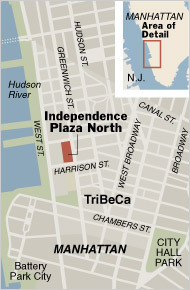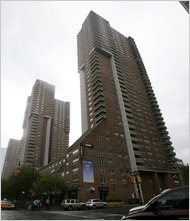The special city tax breaks that the owner of a large apartment complex in TriBeCa received from 2004 to 2006 could hardly be described as a windfall — $17,879.42 for a cluster of buildings in Lower Manhattan worth tens of millions of dollars.
The development, Independence Plaza North, has undergone a transformation since leaving the state’s middle-income Mitchell-Lama housing program, as rents at many apartments have gone from low government-subsidized prices to luxury market-level rates, with one-bedrooms renting for up to $3,800 a month.
The owner, Laurence Gluck of Stellar Management, received the tax breaks, unbeknownst to tenants, for nearly two years after exiting the Mitchell-Lama program in 2004. According to a lawyer for Mr. Gluck, who bought the complex in 2003 for a reported $156 million and pays $8 million a year in property taxes, the relatively tiny savings were unbeknownst to Mr. Gluck as well.
But after one of Mr. Gluck’s 1,300 tenants noticed the tax breaks and questions arose about whether the tax benefits required that the apartments become rent-stabilized, the city allowed Mr. Gluck to repay the amount and retroactively declared that he had never received them.
The receipt and repayment of the tax benefits, part of the city’s J-51 tax program, have sparked a nearly four-year legal battle between tenants and their landlord.
The J-51 tax breaks have been the focus of renewed attention after a ruling last month by the state’s highest court, the Court of Appeals, that the owners of Stuyvesant Town and Peter Cooper Village had wrongfully deregulated apartments while receiving the tax benefits. But the Independence Plaza North case, though lesser known, is older and arguably more complex than the one at Stuyvesant Town and Peter Cooper Village, illustrating the legal quagmire facing some buildings that received the tax breaks and raising questions about the city housing agency’s oversight of the J-51 program.
The Independence Plaza North complex began receiving J-51 tax benefits in 1998, when it was part of the Mitchell-Lama program, and the case centers on tenants’ rent-stabilization status as the development left the program but continued to receive the separate J-51 benefits.
Tenants and their lawyers criticized the housing agency, the Department of Housing Preservation and Development, for providing Mr. Gluck with a legal defense in their lawsuit against him and for failing to notify them that the buildings were receiving J-51 benefits. Residents found out about Independence Plaza North’s J-51 status in March 2005, after a longtime tenant and retired lawyer, Ed Rosner, started digging into the matter. Mr. Rosner and several other tenants believe their apartments should be rent-stabilized. City regulations state that a rental unit that receives the tax benefits is subject to rent regulation, and that rent regulation must continue even after the tax breaks are waived or revoked.
“Everything that happened to tenants here over the last five years might not have happened the way they did had the rules of J-51 been followed,” said Elissa Krauss, 61, a court researcher and member of the Independence Plaza North Tenant Association who has lived at the complex for 15 years.
The housing agency supervised Independence Plaza North while it was in the Mitchell-Lama program and approved the complex’s exit from the program. The agency also administers the J-51 tax program, which gives landlords tax breaks for improvements to their buildings. A spokeswoman for the agency said housing officials did not know that Independence Plaza North was part of the J-51 program as the complex was exiting Mitchell-Lama. That program offers landlords low-interest mortgages and tax abatements in return for caps on rents.
“At the time, this issue had not occurred in prior instances when properties had chosen to opt out of the Mitchell-Lama program, and so was not part of H.P.D.’s review,” said the spokeswoman, Catie Marshall. “As a result, this is now something we routinely check when properties opt out of the Mitchell-Lama program.”
In 2006, Shaun Donovan, then the city’s housing commissioner, wrote in a letter to the Manhattan borough president, Scott M. Stringer, that the agency, “after reviewing the facts as well as equitable and public policy considerations,” determined that the J-51 benefits should have been terminated on the Mitchell-Lama exit date, June 2004.
Yet the agency had taken a different approach with at least one other Mitchell-Lama complex, Starrett City in Brooklyn. In 2007, Mr. Donovan testified before Congress that nearly three-quarters of the units at Starrett City received a J-51 tax exemption, “which makes them subject to rent stabilization” upon exit from the Mitchell-Lama program.
“It illustrates very dramatically what should have happened at I.P.N. and what didn’t happen at I.P.N.,” said Seth A. Miller, a lawyer with the firm Collins, Dobkin & Miller, which represents the tenant association as well as the tenants in the lawsuit.
Stephen Meister, the lead lawyer representing Mr. Gluck in the case, said that since the city retroactively terminated the benefits as of the Mitchell-Lama exit date, the units never became subject to rent stabilization. He said the J-51 benefits were inadvertently granted, because they were supposed to end when the buildings left the Mitchell-Lama program.
“This whole notion that the whole thing should be turned topsy-turvy because of a minuscule amount of J-51 benefits that were mistakenly or inadvertently allowed to continue, and then later reversed and repaid, is ludicrous,” Mr. Meister said.
In April, the judge in the tenants’ lawsuit, Justice Marcy S. Friedman of State Supreme Court in Manhattan, ruled that the question of whether tenants’ apartments were rent-stabilized should be decided by the state housing agency, the Division of Housing and Community Renewal, which oversees rent-regulated apartments. Justice Friedman noted that the city’s rent-stabilization law “does not explicitly address” whether apartments in a building that qualified for J-51 benefits because it was in the Mitchell-Lama program become rent-stabilized if the building continued to receive the tax breaks after leaving the Mitchell-Lama program.
A spokesman for the state housing agency said that officials were making a determination about the complex’s rent-stabilization status, but that it was not known when a decision would be made.
No one is certain what precise impact the Court of Appeals’ ruling in the Stuyvesant Town case will have on thousands of J-51 buildings across the city, but many tenants at Independence Plaza North are hopeful that it will help their long-running case. “A lot of the court action had been very pro-landlord, and this looks like a shift,” said Kathleen McGovern, an occupational therapist and a member of the tenant association who moved into the complex in 1996.
Independence Plaza North — made up of three 39-story residential towers and additional town houses a few blocks north of the World Trade Center site — was built in the mid-1970s and had long been known as one of the best housing deals in Lower Manhattan. When Diane Lapson moved into the complex in 1975, the rent for the two-bedroom apartment she shared was $350. There were no nearby shops or supermarkets, just broken cobblestone streets and empty lots. “It was a part of Manhattan that almost didn’t seem like it was part of Manhattan,” said Ms. Lapson, the president of the tenant association. “It was like a forgotten area.”
There is nothing forgotten, or cheap, about the neighborhood today. Susan Greenberg, 49, a tenant and plaintiff in the lawsuit, said she paid nearly $2,700 for a market-rate one-bedroom apartment, and estimated that her rent would be roughly $1,200 less were her apartment to become rent-stabilized. “It’s hard living in a state of real estate limbo,” Ms. Greenberg said.
Mr. Gluck removed the buildings from the Mitchell-Lama program in 2004, but reached an agreement protecting many tenants from rising rents, a deal that the then-City Council speaker, Gifford Miller, helped broker.
As part of the agreement, many residents received federal vouchers to help them pay rent. Other tenants started receiving yearly rent increases that mimicked those set by the city’s Rent Guidelines Board for rent-stabilized apartments, with additional increases set to begin in 2013. Still other tenants who moved into vacant apartments began paying market rates.
Tenant leaders said that Mr. Gluck did not inform them that the complex was part of the J-51 program during the negotiations over the agreement. Mr. Meister, Mr. Gluck’s lawyer, said that neither the tenants nor the landlord were aware of the J-51 benefits at the time.






